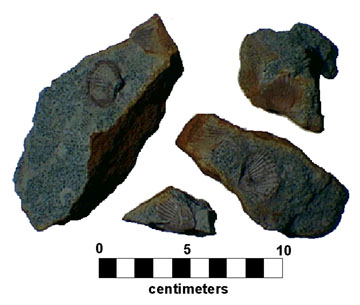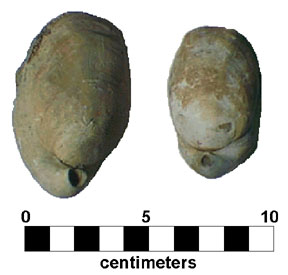Tertiary Stratigraphic Units of the Coastal Plain
BEACON HILL FORMATION - (Pliocene?) - An iron-stained sandy quartz and quartzite-rich gravel deposit that caps of the highest hill in Monmouth County, NJ (Beacon Hill, 373 feet, located just south of the town of Leonardo in the Atlantic Highlands area). The unit probably represents a Pliocene fluvial gravel equivalent to late deposition of the Cohansey Formation. The Beacon Hill crops out at the summits of hills throughout the uplands of the coastal plain, including Apple Pie Hill and other small hills throughout the New Jersey Pine Barrens.
COHANSEY SAND - (Late Miocene to Early Pliocene) - The formation consists of medium to coarse-grained arkosic quartz sand (well stratified and cross-bedded), with thin clay lenses and quartz and quartzite pebble conglomerate. The unit represents a range of sedimentary environments ranging from fluvial to transitional marine environments (swamps, deltas, lagoons, beach sand, and shallow open marine shelf). Sediments at the base of the Cohansey appear to fill broad fluvial channels carved downward into the underlying formations (down to the Tilton in the Atlantic Highlands region). Many beds within the unit are heavily cemented by iron; these ironstone sand and gravel deposits. The Cohansey represents most of the surface deposits throughout the New Jersey Coastal Plain, and is well exposed in road cuts and sand pits throughout the Pine Barrens region. All fossil material appears to be leached out of the Cohansey. The unit's thickness varies from several meters on hilltops to more than 150 feet on the western side of the coastal plain.
KIRKWOOD FORMATION - (Middle Miocene) - The Kirkwood Formation is missing from the Atlantic Highlands section beneath the Cohansey Sand. Further south, the formation consists of a clayey to silty mudrock, massive sand, and thin pebble lenses deposited in a sublittoral to nearshore environments. The unit is equivalent to the Calvert, Choptank, and St. Mary's River formations in Maryland and Virginia. The occurrence of Calvert Cliffs fauna in beach pebbles suggests that the Kirkwood is locally fossiliferous. (This unit has been considered as time equivalent to the formation of the late Tertiary Schooley Peneplane throughout the mountainous Appalachian region.) The base of the Kirkwood sits unconformably in top of older Tertiary units; its thickness is in the range of 100 to 300 feet in the Pine Barrens region.
SHARK RIVER FORMATION - (Eocene) - This unit is also missing beneath the Cohansey Sand in the Atlantic Highlands region, however, it crops out along the creek banks of the Shark River (as the name implies) and contains sharks' and rays' teeth, and molds of shells (Figure 117). The unit consist of a sandy, carbonaceous glauconitic marl and quartz sand. It lies conformably on the Manasquan below. Some researchers do not differentiate the Shark River from the underlying Manasquan Formation.
 |
| Figure 117. Pelecypods in glauconitic marl from the Eocene Shark River Formation. |
MANASQUAN FORMATION - (Eocene) - This unit is missing in the Atlantic Highlands region, however, it crops out along creek bottoms southward along the Jersey Shore in southern Monmouth and Ocean Counties. It consists of a mix of shale and sandy marl with abundant apatite pellets and siderite concretions; fossils are rare or absent. Thickness (including Shark River) varies from 50 to 200 feet.
VINCENTOWN FORMATION - (Paleocene to Eocene) - The Vincentown consists of quartz sand, with phosphatic pellets and glauconite ranging form trace to nearly 100% in some beds (glauconite being most abundant at the base of the unit where it appears gradational with the underlying Hornerstown). Near the shore, fossils are scarce, however, the unit displays bioturbation structures. Elsewhere on the Coastal Plain the Vincentown is extremely fossiliferous containing abundant foraminifera, bryozoa, and a prominent basal shell bed containing Oleneothyris harlani (Figure 118), along with Gryphaea dissimilaris, and bone fragments. Thickness is in the range of 50 to 100 feet.
 |
| Figure 118. The brachiopod Oleneothyris harlani from the Paleocene Vincentown Formation near New Egypt, New Jersey. |
HORNERSTOWN FORMATION - (Early Paleocene [Danian]) - A drastic change in fauna is found at the base of the Hornerstown Formation in New Jersey. This is a reflection of both a mass extinction even as well as a hiatus in deposition. The Hornerstown is lithologically very similar to the Late Cretaceous Tinton Formation consisting of a green glauconitic quartz sand, except that it contains Paleocene fossils. In some locations Cretaceous fossils have been found within the Hornerstown, either reworked from older deposits at the time the unit was deposited, or reworked upward into the basal units by bioturbation. Fossil in the Hornerstown include gastropods, pelecypods, and vertebrate bone material. The unit displays heavy bioturbation.
| Return to Geology of the Coastal Plain Province. |